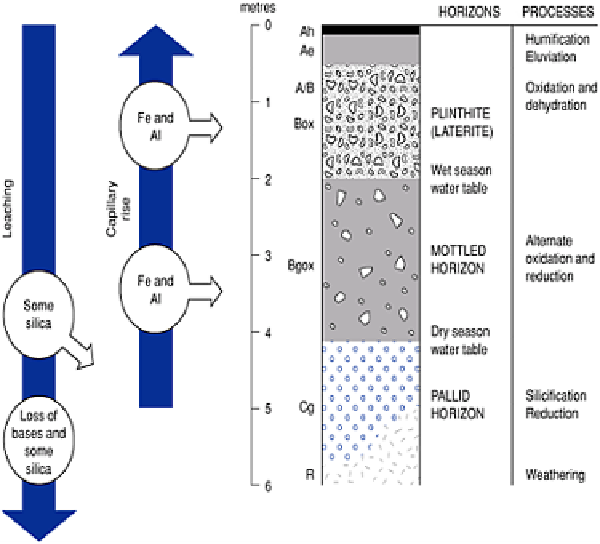Environmental Engineering Reference
In-Depth Information
Figure 19.15
The process of laterization (ferralitization).
strongly developed accumulation of iron and other sesquioxides. This material is used
extensively as a building material in India and Thailand; it is dug out of the ground,
shaped into bricks and allowed to dry irreversibly in the sun. This has given laterite its
name (Latin
later
, 'brick'). This horizon is again about 1·0 m to 1·5 m thick and is the
horizon of cemented ironstone sesquioxides (Box). With depth the soil becomes paler
with distinctive red mottles. This is the mottled zone (B
gox
) which undergoes alternate
oxidation and reduction due to the seasonal changes in the depth of the water table. With
depth the soil becomes paler and paler, often becoming quite white. This is the pallid
horizon (Cg), which is soft, with rock structures often preserved. It is the zone of
permanent reducing conditions and continues down to the weathering rock zone. Thus a
well developed lateritic soil (FAO Ferralsol) will have four distinct zones: a surface zone,
a lateritic zone, a mottled zone and a pallid zone. There is quite a bit of variety from place
to place, with the lateritic and pallid zones varying greatly in thickness. The bright red
colours of lateritic soils are due to the presence of haematite (α Fe
2
O
3
) and goethite (α
FeO.OH) iron oxides; in the pallid zone iron occurs as the hydrated iron oxide lepido-
crocite (γ FeO.OH) and as ferrous compounds.
Owing to the intense leaching, tropical lateritic soils are deficient in major and minor
nutrient elements. Many elements are simply removed from the soil profile, or bound up
in an unavailable form in the iron oxides (e.g. phosphate). There has been some success
in growing commercial crops when fertilizer is applied (e.g. in parts of Australia and
Africa). However, physical conditions are often difficult. In the 1940s the Groundnut

